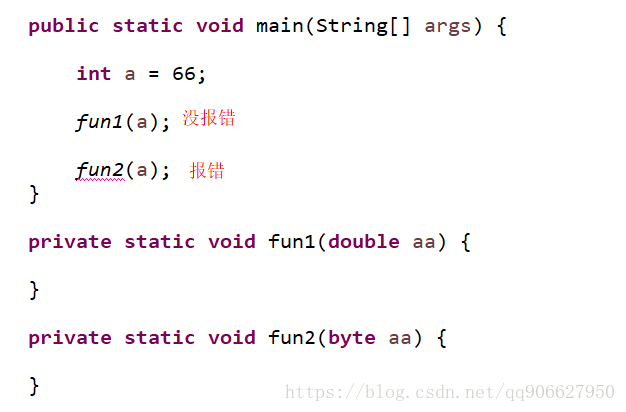жӮЁеҘҪпјҢзҷ»еҪ•еҗҺжүҚиғҪдёӢи®ўеҚ•е“ҰпјҒ
иҝҷзҜҮж–Үз« дё»иҰҒд»Ӣз»ҚдәҶjavaдёӯзұ»еһӢиҮӘеҠЁиҪ¬жҚўжңәеҲ¶зҡ„зӨәдҫӢеҲҶжһҗпјҢе…·жңүдёҖе®ҡеҖҹйүҙд»·еҖјпјҢж„ҹе…ҙи¶Јзҡ„жңӢеҸӢеҸҜд»ҘеҸӮиҖғдёӢпјҢеёҢжңӣеӨ§е®¶йҳ…иҜ»е®ҢиҝҷзҜҮж–Үз« д№ӢеҗҺеӨ§жңү收иҺ·пјҢдёӢйқўи®©е°Ҹзј–еёҰзқҖеӨ§е®¶дёҖиө·дәҶи§ЈдёҖдёӢгҖӮ
иҮӘеҠЁзұ»еһӢиҪ¬жҚўд№ҹеҸ«йҡҗејҸзұ»еһӢиҪ¬жҚў
иЎЁиҫҫејҸзҡ„ж•°жҚ®зұ»еһӢиҮӘеҠЁжҸҗеҚҮ
жүҖжңүзҡ„byteеһӢгҖҒshortеһӢе’Ңcharзҡ„еҖје°Ҷиў«жҸҗеҚҮеҲ°intеһӢгҖӮ
еҰӮжһңдёҖдёӘж“ҚдҪңж•°жҳҜlongеһӢпјҢи®Ўз®—з»“жһңе°ұжҳҜlongеһӢпјӣ
еҰӮжһңдёҖдёӘж“ҚдҪңж•°жҳҜfloatеһӢпјҢи®Ўз®—з»“жһңе°ұжҳҜfloatеһӢпјӣ
еҰӮжһңдёҖдёӘж“ҚдҪңж•°жҳҜdoubleеһӢпјҢи®Ўз®—з»“жһңе°ұжҳҜdoubleеһӢгҖӮ
intеҖјеҸҜд»ҘиөӢеҖјз»ҷlongгҖҒfloatгҖҒdoubleеһӢеҸҳйҮҸпјҢдёҚиғҪиөӢеҖјз»ҷbyteгҖҒshortгҖҒcharеһӢеҸҳйҮҸ

еҜ№дәҺеҮҪж•°зҡ„дј еҸӮд№ҹжҳҜдёҖж ·

еҪ“然пјҢеңЁжңүеҮҪж•°йҮҚиҪҪзҡ„жғ…еҶөдёӢпјҢjavaзј–иҜ‘еҷЁдјҡиҮӘеҠЁйҖүжӢ©жңҖеҢ№й…Қзҡ„еҮҪж•°иҝӣиЎҢи°ғз”Ё

жүҖжңүй•ҝеәҰдҪҺдәҺintзҡ„зұ»еһӢпјҲbyteгҖҒshortгҖҒcharпјүеңЁиҝҗз®—д№ӢеҗҺз»“жһңе°Ҷдјҡиў«жҸҗеҚҮдёәintеһӢ

еҪ“然иҝҳжңүд»ҘдёӢзҡ„иҝҷз§Қжғ…еҶөпјҢиҝҷз§Қжғ…еҶөжҳҜеӣ дёәжҲ‘们еңЁиҝӣиЎҢиөӢеҖјиҝҗз®—зҡ„ж—¶еҖҷпјҢjavaзј–иҜ‘еҷЁеҸҜд»ҘжҳҺзЎ®зҹҘйҒ“иҝҗз®—зҡ„з»“жһңжҳҜеҗҰи¶…иҝҮbyteжҲ–shortзҡ„еҸ–еҖјиҢғеӣҙпјҢжүҖд»Ҙ byte a = 1 + 1; 并没жңүжҠҘй”ҷгҖӮиҖҢдёҠйқў byte c = a + b; зј–иҜ‘еҮәй”ҷзҡ„еҺҹеӣ жҳҜеӣ дёәaе’ҢbеқҮдёәдёҖдёӘеҸҳйҮҸпјҢзӣёеҠ зҡ„з»“жһңжҳҜеҗҰдјҡи¶…иҝҮbyteзҡ„еҸ–еҖјиҢғеӣҙзј–иҜ‘еҷЁе№¶дёҚзҹҘйҒ“пјҢжүҖд»Ҙзј–иҜ‘еҷЁе°Ҷз»“жһңжҸҗеҚҮдёәintеһӢдәҶгҖӮ

е°Ҹз»“дёҖдёӢпјҡ
еҪ“зј–иҜ‘еҷЁжҳҺзЎ®зҹҘйҒ“ж•ҙж•°зҡ„иҝҗз®—з»“жһңжІЎжңүеҲ°иҫҫintзҡ„иЎЁзӨәиҢғеӣҙж—¶пјҢbyteгҖҒshortжҲ–charзұ»еһӢзҡ„иҝҗз®—з»“жһңдёҚдјҡиў«иҮӘеҠЁжҸҗеҚҮдёәintзұ»еһӢ
еҪ“зј–иҜ‘еҷЁжҳҺзЎ®зҹҘйҒ“жҲ–дёҚжё…жҘҡж•ҙж•°зҡ„иҝҗз®—з»“жһңжҳҜеҗҰеҲ°иҫҫintзҡ„иЎЁзӨәиҢғеӣҙж—¶пјҢзј–иҜ‘еҷЁе°ҶдјҡиҮӘеҠЁе°Ҷиҝҗз®—зҡ„з»“жһңиҪ¬жҚўжҲҗintпјҢеҚідҪҝеҺҹжқҘжҳҜbyteгҖҒshortжҲ–charзұ»еһӢгҖӮ
зӯ”пјҡ иөӢеҖј | иҝҗз®—ж—¶ пјҢдёӨиҫ№ж•°жҚ®зұ»еһӢдёҚдёҖиҮҙж—¶е°ұдјҡеҸ‘з”ҹзұ»еһӢиҪ¬жҚў
еҰӮдёӢпјҡ
public class TypeTest {
public static void main(String[] args){
// иҝҗз®—ж—¶еҸ‘з”ҹзҡ„йҡҗејҸзұ»еһӢиҪ¬жҚў,дёӨж•ҙж•°зӣёйҷӨеҫ—еҲ°зҡ„иҝҳжҳҜдёҖдёӘж•ҙж•°
byte a = 3;
byte b = 4;
int num = a + b;
System.out.println(num); // 7
// иөӢеҖјж—¶еҸ‘з”ҹзҡ„йҡҗејҸзұ»еһӢиҪ¬жҚў
int ch = '0';
System.out.println(ch); // 48
// иҝҗз®—ж—¶еҸ‘з”ҹзҡ„ејәеҲ¶зұ»еһӢиҪ¬жҚў
byte a1 = 12;
byte a2 = 12;
byte num1 = (byte)(a1 + a2);
System.out.println(num1); // 24
// иөӢеҖјж—¶еҸ‘з”ҹзҡ„ејәеҲ¶зұ»еһӢиҪ¬жҚў
short b3 = 1234;
byte a3 = (byte) b3;
System.out.println(a3); // -46
}
}иҝҗиЎҢжҲӘеӣҫпјҡ

иҮӘеҠЁзұ»еһӢиҪ¬жҚў
ејәеҲ¶зұ»еһӢиҪ¬жҚў
规еҲҷпјҡд»Һе°ҸеҲ°еӨ§ пјҢдҪҺеӯ—иҠӮеҗ‘й«ҳеӯ—иҠӮиҮӘеҠЁжҸҗеҚҮ
йЎәеәҸпјҡ
byte(1еӯ—иҠӮ) – > short(2еӯ—иҠӮ)-- > int(4еӯ—иҠӮ) – > long(8еӯ—иҠӮ) --> float(4еӯ—иҠӮ) – > double(8еӯ—иҠӮ)
char (2еӯ—иҠӮ)-- > int(4еӯ—иҠӮ) – > long(8еӯ—иҠӮ) --> float(4еӯ—иҠӮ) – > double(8еӯ—иҠӮ)
з”»еӣҫеҲҶжһҗпјҡ

д»Јз Ғеұ•зӨәпјҡ
public class TypeDemo {
public static void main(String[] agrs){
// byte -- > short
byte b1 = 127;
short s1 = b1;
System.out.println(s1); // 127
// short -- > int
short s2 = 30000;
int i = s2;
System.out.println(i); // 30000
// int -- > long
int num = 2100000000;
long lg = num;
System.out.println(num); // 2100000000
// long -- > float
long lg1 = 200000000000000L;
float f1 = lg1;
System.out.println(f1);// 2.00000001E14
// float -- > double
float f2 = 3.14f;
double d1 = f2;
System.out.println(d1); // 3.140000104904175
// char -- > int
char ch = 'a';
int i1 = ch ;
System.out.println(i1); // 97
// char -- > long
char ch2 = 'b';
long lg2 = ch2;
System.out.println(lg2); // 98
// char -- > double
char ch3 = 'c';
double dou = ch3;
System.out.println(dou); // 99.0
// char -- > float
char ch4 = 'd';
float f3 = ch4;
System.out.println(f3); // 100.0
}
}иҝҗиЎҢжҲӘеӣҫпјҡ

жіЁж„Ҹпјҡ
byteгҖҒshortдёҚиғҪе’ҢcharиҝӣиЎҢзӣёдә’иҪ¬жҚў
д»Јз Ғеұ•зӨәпјҡ
public class TypeDemo2 {
public static void main(String[] agrs){
// byte -- > char
byte bt = 127;
char ch = bt;
System.out.println(ch);
// short -- > char
short sh = 12;
char ch2 = sh;
System.out.println(ch2);
}
}зј–иҜ‘й”ҷиҜҜжҲӘеӣҫпјҡ

floatиҷҪ然жҳҜ4дёӘеӯ—иҠӮпјҢдҪҶжҳҜfloatжҜ”longиЎЁзӨәзҡ„ж•°жҚ®иҢғеӣҙжӣҙеӨ§гҖӮиҜҙжҳҺж•°жҚ®иҢғеӣҙзҡ„еӨ§е°Ҹе’Ңеӯ—иҠӮзҡ„еӨ§е°ҸдёҚдёҖе®ҡзӣёе…і
д»Јз Ғеұ•зӨәпјҡ
public class TypeDemo3 {
public static void main(String[] agrs){
long lg = 20000000000000L;
float f1 = lg;
System.out.println(f1); // 1.99999997E13
}
}иҝҗиЎҢжҲӘеӣҫпјҡ

booleanзұ»еһӢдёҚиғҪеҸӮдёҺзұ»еһӢиҪ¬жҚў
д»Јз Ғеұ•зӨәпјҡ
public class TypeDemo4 {
public static void main(String[] agrs) {
boolean flag = 12;
int flag1 = flag;
System.out.println(flag1);
}
}зј–иҜ‘й”ҷиҜҜжҲӘеӣҫпјҡ

规еҲҷпјҡд»ҺеӨ§еҲ°е°ҸпјҢй«ҳеӯ—иҠӮеҗ‘дҪҺеӯ—иҠӮжүӢеҠЁејәеҲ¶иҪ¬жҚў
йЎәеәҸпјҡ
doubleпјҲ8еӯ—иҠӮпјү – > floatпјҲ4еӯ—иҠӮпјү – > longпјҲ8еӯ—иҠӮпјү – > int(4еӯ—иҠӮ) – > short (2еӯ—иҠӮ)-- > byte(1еӯ—иҠӮ)
doubleпјҲ8еӯ—иҠӮпјү – > floatпјҲ4еӯ—иҠӮпјү – > longпјҲ8еӯ—иҠӮпјү – > int(4еӯ—иҠӮ) – > char(2еӯ—иҠӮ)
з”»еӣҫеҲҶжһҗпјҡ

(жҺҢжҸЎ)ж јејҸпјҡзӣ®ж Үж•°жҚ®зұ»еһӢ еҸҳйҮҸеҗҚ = (зӣ®ж Үж•°жҚ®зұ»еһӢ) еҸҳйҮҸ | еёёйҮҸ;
д»Јз Ғеұ•зӨәпјҡ
public class TypeDemo5 {
public static void main(String[] agrs){
// float -- > long
// final float PI = 3.14f;
// long num = (long) PI; // 3
// float little = 3.14f;
// long num = (long)little; // 3
long num = (long)3.14f;
System.out.println(num);// 3
// double -- > float
// double dou = 3.14;
// float little1 = (float)dou; // 3.14
// float little1 = (float) 3.14d; // 3.14
final double dou = 3.14;
float little1 = (float)dou;
System.out.println(little1); // 3.14
// long -- > int
// long num1 = 2000000000000L;
// int num2 = (int)num1; // -1454759936
// int num2 = (int)2000000000000L; // -1454759936
final long num1 = 2000000000000L;
int num2 = (int)num1;
System.out.println(num2); // -1454759936
// int --> short
// int num3 = 12;
// short num4 = (short)num3; // 12
// short num4 = (short)40000; // -25536
final int num3 = 60;
short num4 = (short)num3;
System.out.println(num4); // 60
// short -- > byte
final short sh = 12345;
byte bt = (byte)sh;
System.out.println(bt); // 57
short sh2 = 78;
bt = (byte) sh2;
System.out.println(bt); // 78
}
}иҝҗиЎҢжҲӘеӣҫ:

жіЁж„Ҹпјҡ
ејәеҲ¶зұ»еһӢиҪ¬жҚўжңүж•°жҚ®дёўеӨұпјҢдёҖиҲ¬дёҚе»әи®®дҪҝз”Ё
д»Јз Ғеұ•зӨәпјҡ
public class TypeDemo6 {
public static void main(String[] agrs) {
short a = 1245;
byte b = (byte)a;
System.out.println(b);
}
}иҝҗиЎҢжҲӘеӣҫпјҡ

ж„ҹи°ўдҪ иғҪеӨҹи®Өзңҹйҳ…иҜ»е®ҢиҝҷзҜҮж–Үз« пјҢеёҢжңӣе°Ҹзј–еҲҶдә«зҡ„вҖңjavaдёӯзұ»еһӢиҮӘеҠЁиҪ¬жҚўжңәеҲ¶зҡ„зӨәдҫӢеҲҶжһҗвҖқиҝҷзҜҮж–Үз« еҜ№еӨ§е®¶жңүеё®еҠ©пјҢеҗҢж—¶д№ҹеёҢжңӣеӨ§е®¶еӨҡеӨҡж”ҜжҢҒдәҝйҖҹдә‘пјҢе…іжіЁдәҝйҖҹдә‘иЎҢдёҡиө„и®Ҝйў‘йҒ“пјҢжӣҙеӨҡзӣёе…ізҹҘиҜҶзӯүзқҖдҪ жқҘеӯҰд№ !
е…ҚиҙЈеЈ°жҳҺпјҡжң¬з«ҷеҸ‘еёғзҡ„еҶ…е®№пјҲеӣҫзүҮгҖҒи§Ҷйў‘е’Ңж–Үеӯ—пјүд»ҘеҺҹеҲӣгҖҒиҪ¬иҪҪе’ҢеҲҶдә«дёәдё»пјҢж–Үз« и§ӮзӮ№дёҚд»ЈиЎЁжң¬зҪ‘з«ҷз«ӢеңәпјҢеҰӮжһңж¶үеҸҠдҫөжқғиҜ·иҒ”зі»з«ҷй•ҝйӮ®з®ұпјҡis@yisu.comиҝӣиЎҢдёҫжҠҘпјҢ并жҸҗдҫӣзӣёе…іиҜҒжҚ®пјҢдёҖз»ҸжҹҘе®һпјҢе°Ҷз«ӢеҲ»еҲ йҷӨж¶үе«ҢдҫөжқғеҶ…е®№гҖӮ
жӮЁеҘҪпјҢзҷ»еҪ•еҗҺжүҚиғҪдёӢи®ўеҚ•е“ҰпјҒ